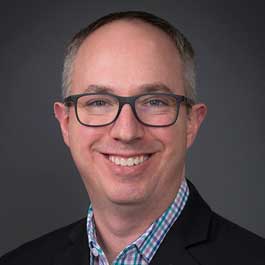
Sr Research Scientist, Global Application Development Lead
Dow
Managing Heat in Electric and Autonomous Vehicles
Joe Sootsman graduated with a PhD in chemistry from Northwestern University in 2009, where he worked on thermoelectric materials with a focus on waste heat recovery in automotive systems by creating nanomaterials that could convert waste heat from cars into energy. Today, he works at Dow, a global materials science company, where he and his team have developed products already in electric and autonomous vehicles on the market.
Throughout his career, Sootsman has worked on composite materials, which are formed by combining two or more materials with different physical and chemical properties. It is something he says he feels fortunate about. At Northwestern, he worked with Charles E. and Emma H. Morrison Professor of Chemistry Mercouri Kanatzidis, Director of the Center for Advanced Materials for Energy and the Environment (CAMEE) at the Institute for Sustainability and Energy at Northwestern (ISEN). The Kanatzidis Research Group explores the design of new materials—particularly solar photovoltaic materials, thermoelectric materials, nanostructured materials, and more.
“I've been pretty fortunate to get to stay in science. I still get to work with customers. I get to work with cross-functional teams of marketing, sales, business development, legal—the whole spectrum—but still get to be a scientist at heart."
—Joe Sootsman, Senior Research Scientist at Dow
At the Kanatzidis lab, Sootsman co-authored 10 papers and filed for a patent. The night Sootsman defended his graduate thesis, he got onto a plane to California, where he would work on commercializing these materials at ZT Plus. Today, after 10 years with Dow, he is the senior research scientist and global application development leader at the company. “I've been pretty fortunate to get to stay in science,” Sootsman says. “I still get to work with customers. I get to work with cross-functional teams of marketing, sales, business development, legal—the whole spectrum—but still get to be a scientist at heart.”
At Dow, Sootsman and his team are creating composite materials, such as electrically conductive adhesives, that provide electromagnetic shielding for parts in electric and autonomous vehicles. These materials limit interference between the car’s radar and, say, a passenger’s cellphone. Other materials are developed for use in battery packs and power electronics to manage heat while the battery is charging and discharging, which helps the pack operate more efficiently. Some encase the car battery to prevent fires or thermal runaways. Cars with these materials are already on the market. “It's really an exciting time to be in the industry, because we can see the materials we work on out on the road in a couple of years,” Sootsman says.
When asked what he finds especially encouraging about his work, Sootsman says, “We make materials that touch some of the most demanding aspects of the vehicle electronic systems.” He adds, “A lot of the projects that I've worked on and I really enjoy [involve] sitting at the design table with our customers to be able to translate their device technical need into what a material would need to do to perform in that system, or in that device.”
To someone looking to pursue a similar career in applied research, Sootsman says to get involved in experiences through outreach with academic and industrial partners. His own graduate research was sponsored by the U.S. Navy. Today, he works across internal teams such as marketing and business development, as well as with customers. “I think it's great to get involved with that kind of cross-functional team that's able to give you the support across multiple uses of the materials that you're working on,” he says. “And really be able to understand not only your part of the project, but much, much broader than that and articulate the broader need of the material or system that you're working in.”